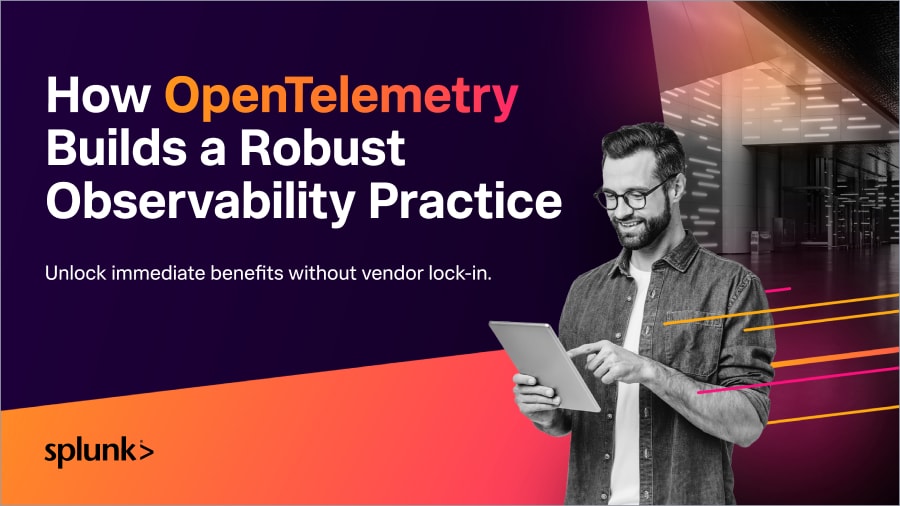Splunk Now Top Contributor to OpenTelemetry

Editor’s note: This post is a collaboration between Tim Tully, Splunk CTO, and Spiros Xanthos, Splunk’s vice president of product management for observability and IT Ops and previously the founder and CEO of Omnition.
 My love for the open-source software movement began with Linux in the ’90s and grew during my time at Yahoo! in the early days of Hadoop. Spiros founded Omnition, a pioneer of distributed tracing and co-founders of the OpenTelemetry project of the Cloud Native Computing Foundation (CNCF). We recently learned that not only is OpenTelemetry the second-most active project of the CNCF (behind only Kubernetes) but Splunk is the number one contributor to the OpenTelemetry project.
My love for the open-source software movement began with Linux in the ’90s and grew during my time at Yahoo! in the early days of Hadoop. Spiros founded Omnition, a pioneer of distributed tracing and co-founders of the OpenTelemetry project of the Cloud Native Computing Foundation (CNCF). We recently learned that not only is OpenTelemetry the second-most active project of the CNCF (behind only Kubernetes) but Splunk is the number one contributor to the OpenTelemetry project.
We’re very happy to see it, but we’re not looking for pats on the back. We contribute to CNCF and OpenTelemetry because it's in the best interest of the community, our new cloud-native world and Splunk customers. Spiros and I expect that open source is the future of software — and OpenTelemetry is the future of observability.
Splunk Is Committed to OpenTelemetry
In Splunk’s Q3 earnings call last year, I said we are 100 percent behind OpenTelemetry as a new standard for the observability world. We have stayed true to that goal. Many of the top contributors to the project work here at Splunk, bringing new ideas and code to OpenTelemetry and supporting the OpenTelemetry community. We contributed the original work for the OpenTelemetry Collector, the code and intellectual property of the SignalFx Smart Agent and Smart Gateway, and many aspects of the auto-instrumentation agents. Most recently we’ve been working on the emerging logging specification, based on Splunk logging specs.
OpenTelemetry Democratizes Data
Splunk is a data company. We help people use the data they have to get the insights they need to run their businesses more efficiently, effectively and profitably. People often say data is a company's most valuable asset. Let's not forget that it’s an asset, not an outcome. The end product is insight and information to help drive decision making and action. The easier it is for companies to gather, ingest and export data in the ways they want, the easier it will be for data to reach its ideal level of value.
In other words, we are confident enough in the value Splunk customers get from our Data-to-Everything Platform that we want to help democratize data collection and let users choose the platform that gives them the most insight and value.
Together We Can Ensure the Success of OpenTelemetry
The benefits of open source are clear. So are the benefits of OpenTelemetry. We’re convinced OpenTelemetry will become an industry standard for observability, benefiting from unprecedented growth over the next few years. In fact, we predict that by the end of 2022, OpenTelemetry will be the most commonly used data instrumentation and collection technology in the world.
We will continue to work toward that goal, and we would love for you to join us. You can start by checking out our recent DevOps Open Source Insights and Innovations virtual event. To other companies, we say it’s time we all work together and fully commit to standardizing on OpenTelemetry. Imagine the incredible explosion of ideas and innovation we would see if we all worked together to make OpenTelemetry the best it can be.

----------------------------------------------------
Thanks!
Tim Tully
----------------------------------------------------
Thanks!
Tim Tully
Related Articles
About Splunk
The world’s leading organizations rely on Splunk, a Cisco company, to continuously strengthen digital resilience with our unified security and observability platform, powered by industry-leading AI.
Our customers trust Splunk’s award-winning security and observability solutions to secure and improve the reliability of their complex digital environments, at any scale.




